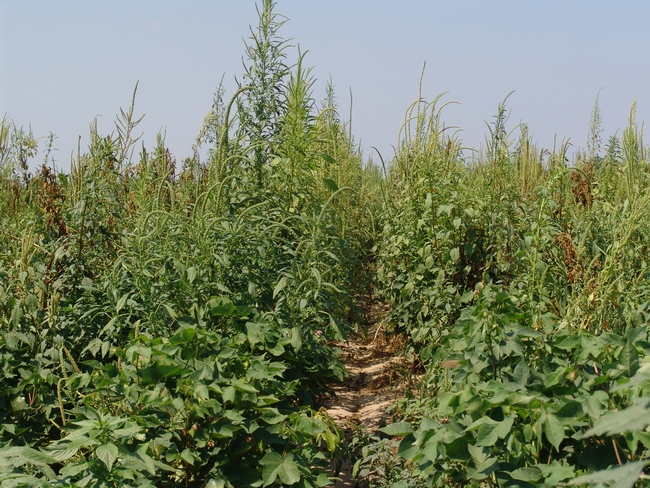- Author: Lynn M. Sosnoskie
- Author: Ted Webster
- Author: Stanley Culpepper
Despite the fact that I am currently working in orchards and vineyards, I receive lots of requests to discuss Palmer amaranth (Amaranthus palmeri S. Wats.), a weed that I spent almost six years studying. It's the scourge of the Southeastern United States - and a weed that I think everyone should be (or at least become) very conscious of.
Considering that Palmer amaranth is starting to rear an ugly head in California cotton and perennial cropping systems, I thought that I might start a series of blogs revisiting some of the research that I was a partner to in Georgia.
First things first, though...what is Palmer amaranth?
Palmer amaranth, also commonly known as careless-weed (because it can get away from you if you are careless...), is a tall (up to two or three meters) and erect summer annual that is native to the Mexican states of Sonora and Baja California, as well parts of southern Arizona and California. A review of the USDA PLANTS database (http://plants.usda.gov) suggests that the species has been encountered in 30 US states and one Canadian province.
The amaranths are sometimes difficult to distinguish from each other, especially at the seedling stage. The best identifiers of Palmer amaranth, to date, include: 1) petioles that are as long, or longer, than the leaf blades and 2) male and female flowers that are held on separate plants in long, terminal spikes. The female flowers possess pointed bracts that make the flower-heads sharp to the touch; male flower-heads, in comparison, are much softer. The reproductive potential of the species is astounding; under ideal growing conditions, a single female plant can produce >500,000 seeds.
For more detailed information regarding the identification of Palmer amaranth, you can refer to the following weed guides: 'Weeds of the South' and 'Weeds of the Midwestern United States and Central Canada' (Disclaimer: I am a contributor to both guides), as well as 'Weeds of the West.'
Figure 2. Male Palmer amaranth. Photo credit: Lynn Sosnoskie, UC-Davis (CA)
Palmer amaranth plants can grow rapidly; the species can easily out-compete corn, soybean, peanuts and cotton if the seedlings become established early in the cropping season. Palmer's rooting structure may also contribute to its competitiveness; results from published studies suggest that Palmer amaranth may produce more roots than soybean and that these roots are potentially more effective at penetrating compacted soil layers (and, therefore accessing additional moisture and nutrients).
According to the International Survey of Herbicide Resistant Weeds (http://www.weedscience.org/In.asp), Palmer amaranth biotypes in the US have developed resistance to the dinitroanilines, photosystem II-inhibitors, ALS-inhibitors , 4-HPPD-inhibitors and glyphosate. Mississippi, Georgia, Kansas and Tennessee have confirmed cases of multiple resistances in Palmer amaranth (i.e. individual biotypes that are resistant to more than one herbicide mechanism of action). In some cases, the resistant biotype is thought to occupy only a few acres; in other instances, the resistant biotype is spread over a majority of the arable farmland. For example, in Georgia, county extension agents estimate that 90% of all cotton acres are infested to some degree with glyphosate-resistant Palmer amaranth.
Herbicide-resistance, particularly glyphosate-resistance, in Palmer amaranth is a significant economic concern for cotton growers in the Southeastern US. Prior to the development of glyphosate-resistance in Palmer amaranth, growers in Georgia spent, on average, $25 to $35 per acre on herbicides for weed control in cotton. Since the discovery of glyphosate-resistance (in 2004), herbicide costs have nearly doubled. The cost of additional, cultural control methods has also increased. From 2000-2005, approximately 3% to 5% of Georgia's cotton acres were hand-weeded at a cost of $2 to $4 per acre (when averaged over all farm acres); from 2006-2010, 50% to 70% of all cotton acres were hand-weeded at an average cost of $22 to $24 per acre.
Figure 3. Palmer amaranth infesting cotton. Photo credit: Larry Steckel, UT (TN).


